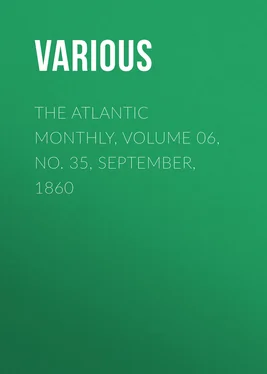Various - The Atlantic Monthly, Volume 06, No. 35, September, 1860
Здесь есть возможность читать онлайн «Various - The Atlantic Monthly, Volume 06, No. 35, September, 1860» — ознакомительный отрывок электронной книги совершенно бесплатно, а после прочтения отрывка купить полную версию. В некоторых случаях можно слушать аудио, скачать через торрент в формате fb2 и присутствует краткое содержание. Жанр: foreign_antique, periodic, foreign_edu, на английском языке. Описание произведения, (предисловие) а так же отзывы посетителей доступны на портале библиотеки ЛибКат.
- Название:The Atlantic Monthly, Volume 06, No. 35, September, 1860
- Автор:
- Жанр:
- Год:неизвестен
- ISBN:нет данных
- Рейтинг книги:5 / 5. Голосов: 1
-
Избранное:Добавить в избранное
- Отзывы:
-
Ваша оценка:
- 100
- 1
- 2
- 3
- 4
- 5
The Atlantic Monthly, Volume 06, No. 35, September, 1860: краткое содержание, описание и аннотация
Предлагаем к чтению аннотацию, описание, краткое содержание или предисловие (зависит от того, что написал сам автор книги «The Atlantic Monthly, Volume 06, No. 35, September, 1860»). Если вы не нашли необходимую информацию о книге — напишите в комментариях, мы постараемся отыскать её.
The Atlantic Monthly, Volume 06, No. 35, September, 1860 — читать онлайн ознакомительный отрывок
Ниже представлен текст книги, разбитый по страницам. Система сохранения места последней прочитанной страницы, позволяет с удобством читать онлайн бесплатно книгу «The Atlantic Monthly, Volume 06, No. 35, September, 1860», без необходимости каждый раз заново искать на чём Вы остановились. Поставьте закладку, и сможете в любой момент перейти на страницу, на которой закончили чтение.
Интервал:
Закладка:
When I look upon a noble Elm,—though I feel no disposition to contemn the studies of those who examine its flowers and fruit with the scrutinizing eye of science, or the calculations of those who consider only its practical use—it is to me an object of pleasing veneration. I look upon it as the embodiment of some benign intention of Providence, who has adapted it in numerous ways to the wants of his creatures. While admiring its grace and its majesty, I think of the great amount of human happiness and of comfort to the inferior animals of which it has been the blessed instrument. How many a happy assemblage of children and young persons has been, during the past century, repeatedly gathered under its shade, in the sultry noons of summer! How many a young May-queen has been crowned under its roof, when the greensward was just daisied with the early flowers of spring! And how many a weary traveller has rested from his journey in its benevolent shade, and from a state of weariness and vexation, when o'erspent by heat and length of way, has subsided into one of quiet thankfulness and content!
Though the Elm has never been consecrated by the Muse, or dignified by making a figure in the paintings of the old masters, the native inhabitant of New England associates its varied forms with all that is delightful in the scenery of his own land or memorable in its history. He has beheld many a noble avenue formed of Elms, when standing in rows in the village, or by the rustic road-side. He has seen them extending their broad and benevolent arms as a protection over many a spacious old farm-house and many an humble cottage, and equally harmonizing with all. They meet his sight in the public grounds of the city, with their ample shade and flowing spray, inviting him to linger under their pleasant umbrage in summer; and in winter he has beheld them among the rude hills and mountains, like spectral figures keeping sentry among their passes, and, on the waking of the year, suddenly transformed into towers of luxuriant verdure and beauty. Every year of his life has he seen the beautiful Hang-Bird weave his pensile habitation upon the long and flexible branches of the Elm, secure from the reach of every living creature. From its vast dome of interwoven branches and foliage he has listened to the songs of the earliest and the latest birds; and under its shelter he has witnessed many a merry-making assemblage of children, employed in the sportive games of summer.
To a native of New England, therefore, the Elm has a value more nearly approaching that of sacredness than any other tree. Setting aside the pleasure derived from it as an object of visual beauty, it is intimately associated with the familiar scenes of home and the events of his early life. In my own mind it is pleasingly allied with those old dwelling-houses which were built in the early part of the last century, and form one of the marked features of New England home architecture during that period. They are known by their broad and ample, but low-studded rooms, their numerous windows with small panes, their single chimney in the centre of the roof that sloped down to the lower story in the back part, and in their general unpretending appearance, reminding one vividly of that simplicity of life which characterized our people before the Revolution. Their very homeliness is delightful, by leaving the imagination free to dwell upon their pleasing suggestions. Not many of these charming old houses are now extant: but whenever we see one, we are almost sure to find it accompanied by its Elm, standing upon the green open space that slopes up to it in front, and waving its long branches in melancholy grandeur over the venerable habitation which it seems to have taken under its protection, while it droops with sorrow over the infirmities of its old companion of a century.
The Elm is remarkable for the variety of forms which it assumes in different situations. Often it has a drooping spray only when it has attained a large size; but it almost invariably becomes subdivided into several equal branches, diverging from a common centre, at a considerable elevation from the ground. One of these forms is that of a vase: the base being represented by the roots of the tree that project above the soil and join the trunk,—the middle by the lower part of the principal branches, as they swell out with a graceful curve, then gradually diverge, until they bend downward and form the lip of the vase, by their circle of terminal branches. Another of its forms is that of a vast dome, as represented by those trees that send up a single shaft to the height of twenty feet or more, and then extend their branches at a wide divergency and to a great length. The Elms which are remarkable for their drooping character are usually of this shape. At other times the Elm assumes the shape of a plume, presenting a singularly fantastical appearance. It rises upwards, with an undivided shaft, to the height of fifty feet or more, without a limb, and bending over with a gradual curve from about the middle of its height to its summit, which is sometimes divided into two or three terminal branches. The whole is covered from its roots to its summit with a fringe of vine-like twigs, extremely slender, twisted and irregular, and resembling a parasitic growth. Sometimes it is subdivided at the usual height into three or four long branches, which are wreathed In the same manner, and form a compound plume.
These fantastic forms are very beautiful, and do not impress one with the idea of monstrosity, as we are affected by the sight of a Weeping Ash. Though the Elm has many defects of foliage, and is destitute of those fine autumnal tints which are so remarkable in some other trees, it is still almost without a rival in the American forest. It presents a variety in its forms not to be seen in any other tree,—possessing the dignity of the Oak without its ruggedness, and uniting the grace of the slender Birch with the lofty grandeur of the Palm and the majesty of the Cedar of Lebanon.
Of the parasol-trees the North furnishes no true examples, which are witnessed only in the Palms of the tropics. Not many of our inhabitants have seen these trees in their living beauty; but all have become so familiar with them, as they are represented in paintings and engravings, that they can easily appreciate their effect in the sunny landscapes of the South. There they may be seen bending over fields tapestried with Passion-Flowers and verdurous with Myrtles and Orange-trees, and presenting their long shafts to the tendrils of the Trumpet Honeysuckle and the palmate foliage of the Climbing Fern. But the slender Palms, when solitary, afford but little shade. It is when they are standing in groups, their lofty tops meeting and forming a uniform umbrage, that they afford any important protection from the heat of the sun.
In pictures of tropical scenery we see these trees standing on the banks of a stream, or in the vicinity of the sea, near some rude hut constructed of Bamboo and thatched with the broad leaves of the Fan Palm. In some warm countries Nature affords the inhabitants an almost gratuitous subsistence from the fruit of the different Palms,—a plantation of Dates and Cocoa-nuts supplying the principal wants of the owner and his family, during the life of the trees. But the Palm is not suggestive of the arts, for the South is not the region of the highest civilization. Man's intelligence is greatest in those countries in which he is obliged to struggle with difficulties sufficient to require the constant exercise of the mind and body to overcome them. Science and Art have built their altars in the region of the Oak, and in valleys which are annually whitened with snow, where labor invigorates the frame, and where man's contention with the difficulties presented by the elements sharpens his ingenuity and strengthens all his facilities. Hence, while the Oak is the symbol of hospitality and of the arts to which it has given its aid, the Palm symbolizes the voluptuousness of a tropical clime and the indolence of its inhabitants.
Читать дальшеИнтервал:
Закладка:
Похожие книги на «The Atlantic Monthly, Volume 06, No. 35, September, 1860»
Представляем Вашему вниманию похожие книги на «The Atlantic Monthly, Volume 06, No. 35, September, 1860» списком для выбора. Мы отобрали схожую по названию и смыслу литературу в надежде предоставить читателям больше вариантов отыскать новые, интересные, ещё непрочитанные произведения.
Обсуждение, отзывы о книге «The Atlantic Monthly, Volume 06, No. 35, September, 1860» и просто собственные мнения читателей. Оставьте ваши комментарии, напишите, что Вы думаете о произведении, его смысле или главных героях. Укажите что конкретно понравилось, а что нет, и почему Вы так считаете.












